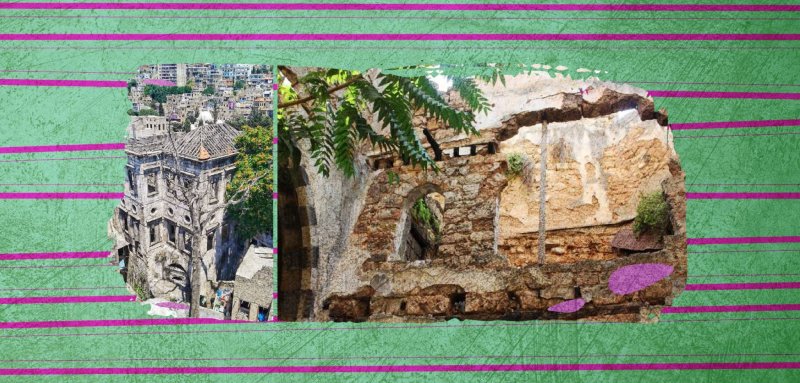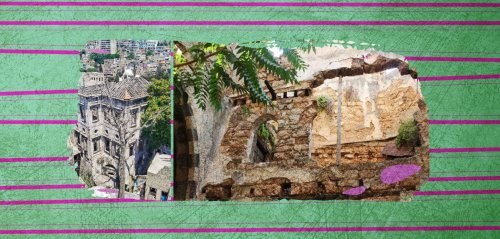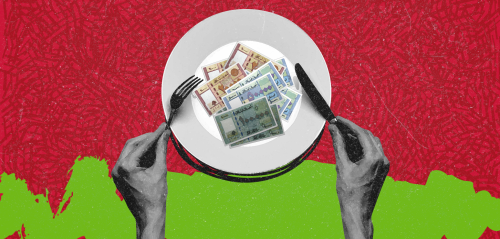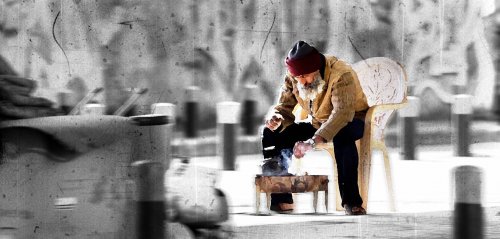Young Jumana Deko could have lived her life and had a peaceful childhood like all other children, but she passed away at the tender age of two after a three-story building in the locality of Dahr el-Maghar in Tripoli, northern Lebanon, collapsed in June 2022.
The Dahr el-Maghar building was not the first and will not be the last. In Tripoli, more than 300 buildings are in danger of collapse. Living in these buildings are hundreds of forgotten people whose lives are at risk. Jumana is not the only victim. Like her, Abdel Rahman Kakhieh, 21, and his sister Rama, 18, died in the collapse of the al-Fawal building in the city's port in 2019, and like them two sisters fell victim to the collapse of the balcony of a residential house in the al-Qoubbeh area in October 2021... This direct threat to human life and health, and to the historical and cultural heritage of the city continues, amid the systematic neglect of the second largest city in Lebanon.
Who stole the city?
The city has witnessed many events that have claimed buildings of historical and archaeological importance, and led to casualties, starting with the flood of the Abu Ali River in 1958, which led to heavy human and urban losses, and ending with the random civil state plans to repair what the flooding had caused, which led to the unauthorized bulldozing of archaeological areas in an uninformed way and the distortion of the archaeological urban structure of the city.
As soon as the city began to recover after the flood, the civil war came in 1975, leaving cracks and ruin in the city's ancient buildings. As a result, most families who own heritage buildings had to abandon them and go to safer buildings, and poor families have settled in these buildings, which are often concentrated in the old city. Most of them have stayed there until now in exchange for cheap rent, in what is now known as "old rents".
"Old rents" are lease contracts that were made before 1992, which the authorities had decided to make without a time limit. Thus the tenants remained in them and continued to pay the same rental value mentioned in the contract. These nominal amounts have become symbolic over time, with the collapse of the value of the Lebanese currency at the end of the eighties and the beginning of the nineties.
According to estimates by the General Directorate of Antiquities (DGA) of the Ministry of Culture, the number of cracked and dilapidated buildings in Tripoli has reached 300, some of which are on the verge of collapse. The study dates back to 2018, meaning that the number may have increased now. The residents of these buildings often do not have an alternative and cannot rent safe housing due to their economic conditions.
What did the state offer the city?
In his answer regarding the fate of the threatened ancient buildings, the current president of the Heritage and Historical Monuments Sub-Committee of the Municipality of Tripoli, Dr. Khaled Tadmouri, indicated that the committee does not have the authority to establish a financial fund to bear the burden of renovating or restoring archaeological buildings or monuments, but its authority is limited to submitting proposals and projects to improve the city's situation as a whole, or to play a supervisory role in the event of obtaining international or local aid.
What complicates the problem, Tadmouri adds, is that a large number of these buildings are private property or belong to the Islamic Awqaf Directorate, while the municipality can only deal with a registered property of the state. The Directorate General of Antiquities (DGA) of the Ministry of Culture has also set impossible conditions for the restoration of monuments in the buildings, namely consulting specialized engineers to restore and strengthen decorations and architectural elements, which requires a large financial budget. All this forces owners to leave buildings as they are until they collapse, while they look for housing in modern buildings.
After the civil war, the state established the Ministry of Displaced Persons, and one of its tasks was to repair the damage caused by the war, but Tadmouri points out that this ministry did not put Tripoli on its work map at all. It renovated buildings that were not previously inhabited and no one lived in them following the renovations, just like what had happened in the Mount Lebanon governorate. This all took place at the expense of other areas with buildings in dire need of restoration, such as Tripoli, which means that the ministry's plan was not well thought out at all.
In Tripoli more than 300 buildings are in danger of collapse, where forgotten people live, their lives at risk. This direct threat to human life, and the historical and cultural heritage of the city continues amidst systematic neglect of Lebanon's 2nd largest city
Tadmouri holds the city's official representatives responsible, as they haven't done anything and did not call for the rights of the city and its people, alongside the owners of these buildings, most of whom belong to ancient and well-known Tripolitan families. In his view, the responsibility was lost to the large number of those who bear it.
One of the solutions proposed by Tadmouri is for a private company such as Solidere to take over the renovation and restoration of the buildings, so that it would buy all these properties and assume responsibility for them... This solution, if implemented, may mean that Tripoli faces a new distortion of its identity, similar to what the city of Beirut experienced after the civil war; its memory and history being erased in favor of modern commercial construction, in exchange for the loss of rights of the owners and the residents, in the absence of alternatives or housing plans.
The palaces of the city
Like many ancient buildings, both inhabited and uninhabited, Tripoli's ancient archaeological palaces are in danger of falling or collapsing. In the locality of the fish market, one of the souks of the old city, lies the palace of the "muqaddam", known as the Shaheen Palace. The residents we spoke to complained about the danger it poses if it collapses, especially since it is inhabited by a poor family awaiting its fate.

On the opposite side is the very dilapidated Khoder Agha Palace where a Syrian family lives, and faces real danger if the building falls. Residents of the neighborhood told us that they had repeatedly asked for the help of the municipality and those concerned since 2016, but their cries for help only resulted in one of the palace's walls being reinforced with a piece of wood.

Paper agreements
Bassem Zodeh, an engineer specialized in the restoration of archaeological buildings and documentation of decorations in Tripoli, explains that these buildings are very old, which has left their urban structure in a critical condition, not to mention that the period of civil war worsened the situation, especially with the construction of illegal layers on top of the old construction without building permits, in addition to the indiscriminate bombardment that Tripoli has been subjected to since the 1970s, up to the regional conflict between Jabal Mohsen and Bab al-Tabbaneh between 2008 and 2015, and thus these archaeological buildings have become a real threat to public safety.
According to information we collected from a number of activists, all the calls and appeals to the municipality and the Directorate of Antiquities brought no results, due to the lack of financial means, in addition to problems and disagreement among the members of the municipal council on benefiting from the projects and dividing quotas.
With the Lebanese state's lack of presence in Tripoli as if its people's lives were insignificant, will the city whose gate displays the words "Enter in peace and security" become a mass grave, devouring thousands of lives under the rubble of the crumbling buildings?
In 2017, before the current crisis, the Directorate of Antiquities held a closed meeting in the presence of former Mayor Ahmed Qamaruddin and other members of the Tripoli Citadel, and it was agreed to establish a special fund to support dilapidated buildings and palaces, provided that the municipality allocates three billion Lebanese pounds ($2 million dollars at the time), and that the directorate pledge to provide it with funds from donors, grants, and the assistance that it can get. The attendees then toured Tripoli to inspect the conditions of some of the dilapidated buildings, but nothing of the agreement has been implemented to this day.
Due to the absence of any official evidence other than the testimony of one of the attendees at this meeting and some photos from the tour, we contacted Qamaruddin to find out more about the fate of these decisions, but he did not show any cooperation, and did not answer any inquiries in this regard.

Photo from the tour of the dilapidated buildings: From the top, the head of the Antiquities Committee of the Azm and Saade Association Jamal Saati, Engineer Jamil Jablawi, former mayor Ahmed Qamaruddin, and other members of the General Directorate of Antiquities.
On the east bank of the Abu Ali River stretches a long strip of misery; al-Bahsa, al-Hara al-Baraniyah, Qoubbeh, Tabbaneh, and al-Beddawi... This currently impoverished area is actually a rich historical city that has turned into ruins and is inhabited by families who have no other shelter, inside dilapidated buildings that have not seen any maintenance or restoration in decades.
With the Lebanese state's lack of presence in Tripoli, as if the lives of its people were insignificant, will the city whose gate proudly displays the words "Enter it in peace and security", become a mass grave, devouring the lives of thousands under the rubble of buildings that are about to collapse?
*This investigative report has been published in cooperation with the Lebanese Association for Scientific Research (LASeR) and under the supervision of journalist Pascal Sawma.
Raseef22 is a not for profit entity. Our focus is on quality journalism. Every contribution to the NasRaseef membership goes directly towards journalism production. We stand independent, not accepting corporate sponsorships, sponsored content or political funding.
Support our mission to keep Raseef22 available to all readers by clicking here!
Interested in writing with us? Check our pitch process here!







